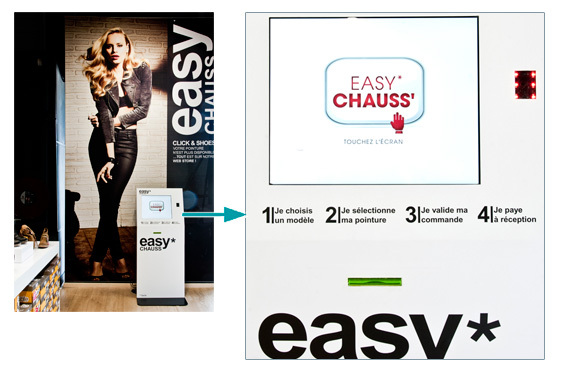22/01/2014 | Hardis Group
La Halle Chaussures et Maroquinerie lets its customers order shoes that are not available in the shops directly via an interactive touch screen terminal connected to their e-commerce platform.

Hardis Group, a service, consulting, business software publishing and facilities management company announces that Compagnie Européenne de la Chaussure has entrusted it with the development of an application designed to enable customers of La Halle Chaussures et Maroquinerie to order products that are not available in shops, from touch screen terminals. Connected to the online sales website, the application was designed in HTML5 with the IBM Worklight platform, to meet the immediate need for touch screen terminals and anticipate the development of new services on mobile applications.
An integrated network of 740 shops
Compagnie Européenne de la Chaussure (C.E.C.) is a subsidiary of the Vivarte group. It owns and manages a network of 740 shops ranging from 300 to 1,200 m2, in and around towns, under the name La Halle Chaussures et Maroquinerie. Since 2010, C.E.C. has also been offering its customers the opportunity to order on line on a dedicated e-commerce site.
But the varying sizes of the La Halle Chaussures et Maroquinerie shops means that they cannot each display and store all the references available on the website. In order not to disappoint customers who have gone to the shop after spotting models on the Internet, it became imperative to equip the shops with touch screen terminals so that customers can choose, order and pay directly in the shop. These terminals would also be used to order models with out-of-stock sizes or colors in the shop.
In-shop screens connected to the e-commerce platform
Compagnie Européenne de la Chaussure ISD is quite logically planning to tackle the project as an extension of the online sales site developed in Magento. "The processes and logistical flows of orders from these terminals were going to be identical to those used for e-commerce," says Jérôme Bergeret, company ISD. This would make it possible to meet the request of the e-commerce team to add free pick-up from the shop to the available online delivery methods, in addition to home delivery or relay points, which are subject to charges.
The ISD then naturally turned to the Web agency in charge of the e-commerce project, who also hosts the platform. "They are highly skilled when it comes to developing and managing an online sales website selling, but we quickly felt they were not familiar with the issues related to the specifics of point-of-sale touch equipment, such as terminals or tablets," says Jérôme Bergeret. The decision was therefore made to call on a service company with broader technological skills, especially for managing tactility.
IBM Worklight, in anticipation of mobility
A call for tender was launched, and three IT Services & Software Engineering companies lined up, each with very different solutions. One of them was Hardis who put forward a proposal based on the IBM Worklight development platform, taking into account the initial need for development of touch screen terminals, but also the inevitable next step: the development of new services on mobile applications. "In addition to the technological strength of IBM, we were attracted by the long-term approach of the Hardis staff," says Jérôme Bergeret, "They were not content just to meet our immediate challenge, but were already looking to the next step: mobility. Especially as sales via mobiles already account for 8-12 % of our turnover, with a website that was not particularly designed for this channel".
In January 2013, the decision was made: in addition to developing the touch application, Hardis was to coordinate and control the overall project, which involves the terminal manufacturer, the web agency that hosts and manages the e-shop, and of course the ISD teams of the Compagnie Européenne de la Chaussure. After a project kick-off meeting in March, a prototype was developed. "The Hardis iteration methodology, which gave us a deliverable every two to three weeks, helps discussion and enables us to make any necessary adjustments as we go along," says the ISD.
Simplifying and accelerating deployment to reduce time-to-market
Among the project goals, ease of deployment in retail outlets was a priority for the initial implementation, but also to be able to make regular updates, in line with campaigns (promotions, sales, seasonal features, etc.) or changes that the marketing department wants to make. Compagnie Européenne de la Chaussure wanted to be able to use standard and lightweight technologies to avoid having to update terminals, one by one, with each development, without sacrificing performance. This was why Hardis proposed using the Chrome browser, HTML5, CSS3 and JavaScript, encapsulated in IBM Worklight. This technical decision means that interconnecting the solution, hosted by Hardis, with the e-commerce platform, hosted by the web agency, can be further facilitated.
After a test phase conducted in two shops in spring 2013, followed by a broader pilot phase over some twenty outlets in the course of the summer, 100 to 200 terminals should be deployed in one year. All shops will ultimately be equipped with the terminals. "These terminals will allow us to gradually introduce new services in the retail outlets, without altering our business model, which is built on customer autonomy," continues Jérôme Bergeret. "And with the technology choices proposed by Hardis, we can now consider the stage of mobility, while limiting recurrent costs, since ultimately touch screen terminals and mobility will be managed with the same platform," he concludes.
Hardis provides support for La Halle Chaussures et Maroquinerie with its cross-channel strategy
